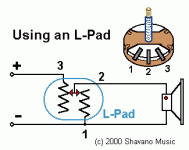Speaker Crossover Calculators
I found this awesome calculator. Want to do a hi-pass x-over for SEAS Prestige 27TFFNC/G tweeter at 4-5kHz combined with 6dB attenuation (based on measurements using variable LCR pot I got from Parts-Express).
My questions are:
1) Can I just put the capacitor in series in front of the 2 resistor attenuation circuit?
2) I thought proper attenuation required LCR, not just 2 resistors. Is there any disadvantage to just using the 2 resistors shown in this calculator?
I chose the SEAS Prestige 27TFFNC/G tweeter because the small size allows me to put it very close to the mid-woofer. I figure with an x-over this high, it is more important to get better dispersion than any improvement in sound quality.
https://www.madisoundspeakerstore.c...stige-27tffnc/g-h1396-1-textile-dome-tweeter/
Strange thing is the identical tweeter but in rectangular shape gives a smoother output
https://www.madisoundspeakerstore.c...7tffnc/cg-h1406-1-textile-dome-tweeter-4-ohm/
I found this awesome calculator. Want to do a hi-pass x-over for SEAS Prestige 27TFFNC/G tweeter at 4-5kHz combined with 6dB attenuation (based on measurements using variable LCR pot I got from Parts-Express).
My questions are:
1) Can I just put the capacitor in series in front of the 2 resistor attenuation circuit?
2) I thought proper attenuation required LCR, not just 2 resistors. Is there any disadvantage to just using the 2 resistors shown in this calculator?
I chose the SEAS Prestige 27TFFNC/G tweeter because the small size allows me to put it very close to the mid-woofer. I figure with an x-over this high, it is more important to get better dispersion than any improvement in sound quality.
https://www.madisoundspeakerstore.c...stige-27tffnc/g-h1396-1-textile-dome-tweeter/
Strange thing is the identical tweeter but in rectangular shape gives a smoother output
https://www.madisoundspeakerstore.c...7tffnc/cg-h1406-1-textile-dome-tweeter-4-ohm/
Yes, you can put the capacitor before the L-pad. Putting it after would be different.
Your interest in the LCR suggests you are ready to put these values in a simulator.
Your interest in the LCR suggests you are ready to put these values in a simulator.
(based on measurements using variable LCR pot I got from Parts-Express)
By "variable LCR pot", do you perhaps mean an L-pad?
An L-pad allows you to vary the size of the series and parallel resistors to provide different degrees of attenuation - an advantage over two fixed resistors.
Attachments
Speaker L-Pad Attenuator 15W Mono 1" Shaft 8 Ohm
Great AllenB! I will do the cap first. Yes, the L-pad is okay to test volume but sound is not so good. It gets static when I turn the knob up and down.
Galu, I see. That is a good diagram. So it is resistors only, One in series and the other parallel across the tweeter terminals. Steep learning curve but Is simple once you understand it.
Great AllenB! I will do the cap first. Yes, the L-pad is okay to test volume but sound is not so good. It gets static when I turn the knob up and down.
Galu, I see. That is a good diagram. So it is resistors only, One in series and the other parallel across the tweeter terminals. Steep learning curve but Is simple once you understand it.
